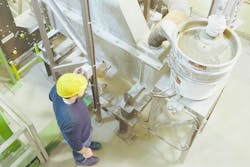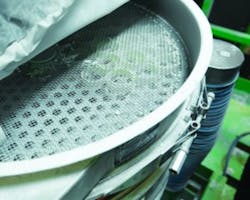Process converts excess phosphorus, nitrogen into fertilizer
Saskatoon, the largest city in Saskatchewan, Canada, turns excess phosphorus accumulating in its wastewater treatment system into a slow-release, environmentally friendly fertilizer.
A reactor system first transforms the wastewater’s excess phosphorus and nitrogen into fertilizer pellets. Then, a single-deck circular vibratory screener dewaters the pellets, and a five-deck classifier separates the final dried pellets into four commercial sizes sold as Crystal Green fertilizer.
Saskatoon’s wastewater treatment plant, built in 1971, was expanded several times to comply with environmental regulations and to serve the city’s growing population, which today includes more than 300,000 residents.
In 1991, an enhanced biological phosphorus removal (EBPR) process was installed to meet discharge permit limits for the South Saskatchewan River.
Phosphorus accumulation
In the EBPR process, microbes known as phosphorus accumulating organisms remove phosphorus from the incoming wastewater stream of more than 22 million gallons per day. The resulting biomass is piped about 7.5 miles to settling lagoons where it is aerobically digested and dewatered.
The biosolids taken from the lagoons are applied to farmland, and the supernatant liquid leftover is pumped through a second pipeline of about the same length as the first back to the wastewater plant inflow.
Although EBPR has advantages over chemical phosphorus removal, the accumulation of sludge releases phosphorus back into solution, resulting in greater loads of phosphorus and other nutrients — such as ammonia and magnesium — circling back to the main treatment process.
The nutrient overload promoted formation of a precipitate called struvite — also known as magnesium ammonium phosphate hexahydrate — that coated pipes, valves and other equipment, reducing plant-flow capacities and increasing maintenance requirements.
To meet the challenges involved, the city of Saskatoon commissioned Ostara Nutrient Recovery Technologies Inc. to install Canada’s first commercial facility to recover phosphorus and nitrogen.
"Struvite formation was challenging operational reliability and reducing process efficiency," says Derek Lycke, Ostara director of engineering.
The company was also tasked to transform the phosphorus and nitrogen into more than 80 tons per year of the slow-release, environmentally responsible, enhanced efficiency fertilizer Crystal Green.
An oyster forms a pearl
The heart of the nutrient recovery process is Ostara’s Pearl 2000 fluidized bed reactor. The nitrogen (ammonia) and phosphorus-rich sludge water is fed into the reactor, and magnesium chloride is added separately.
Additional phosphorus and magnesium are fed to the reactor by a waste-activated sludge-stripping process that takes both nutrients out of the sludge. Stripping makes as much as 40 percent more phosphorus available for recovery and further controls struvite scale formation throughout the sludge treatment stream.
The Pearl reactor removes 90 percent of phosphorus and 40 percent of nitrogen from its feed water, and converts them into the high-value fertilizer. Microscopic crystals of struvite — with each crystal containing both nitrogen and phosphorus — form in the reactor, like a pearl, and grow until they reach desired particle size of 1.0 to 3.5 millimeter (mm) diameter for the fertilizer product.
"The result is struvite in the form of extremely pure, crystalline pellets, also known as prills," Lycke says. “They are batch harvested from the reactor in slurry consisting of approximately 10 percent solids by weight at a rate of 1.0 to 1.5 kilograms/minute."
Circular screener dewaters
The fertilizer pellets are dewatered using a vibratory screen fitted with an anti-blinding device to forestall agglomeration.
"Following harvest, Fertilizer finishing takes places in batch mode after the harvest.
"First, the Kason Vibroscreen 30 inch-diameter, single-deck screener dewaters — as in separating solids from liquid — the prills to a moisture content of 18 to 20 percent,” Lycke says. “The screener also helps spread out and equalize the flow to the horizontal fluid bed dryer."
In operation, an imbalanced-weight gyratory motor imparts multi-plane inertial vibration to the screen deck, causing solid particles to migrate across the 35 mesh screen and exit through the upper discharge spout. The liquid flows through the screen apertures, exiting through the lower discharge spout and returning to the head end of the treatment process. The particles smaller than 35 mesh are captured.
Because the solids tend to agglomerate, an anti-blinding device is fitted atop the screen. The device consists of plastic rings that the screener’s vibration continuously moves across a perforated stainless steel plate with apertures slightly larger than those of the screen beneath. The ring’s motion across the steel plate shears and scrapes the clumping particles, so they pass through the screen. The hollow rings promote product flow over the entire screen surface, maximizing screening efficiency.
The screened and dewatered particles pass to the horizontal fluid bed dryer, which further reduces their moisture content to 0.5 percent. Using heat, air flow and vibration, the unit separates and fluidizes individual particles to maximize drying.
Pellets at commercial sizes
Following the fluid-bed dryer, the five-deck, 32-inch diameter classifier separates the prills into four fractions ranging from 3.5 to 1.0 mm. The top deck has a 6 mesh screen. Each deck below has a screen with smaller apertures than the one above it: 8 mesh, 14 mesh and 18 mesh. Thus, any particles smaller than 18 mesh exit the bottom deck’s discharge spout.
Each screening deck is fitted with the same anti-blinding rings as the dewatering screener. The classifier separates the pellets based on the same multi-plane inertial vibration principle as the single-deck screener.
The product is distributed by fertilizer blending firms and distributors to farmers; superintendents; and growers in the agriculture, turf and horticulture markets throughout North America. In general, the small size grades are blended for turf applications such as golf courses, while the larger size grades are blended for specialty and commercial agriculture.
The city of Saskatoon receives a share of the revenue generated from fertilizer sales, which helps offset the costs of the system.
Henry Alamzed is president of Kason Corp., a Milburn, New Jersey-based maker of screening, sifting and fluid bed processing equipment.

